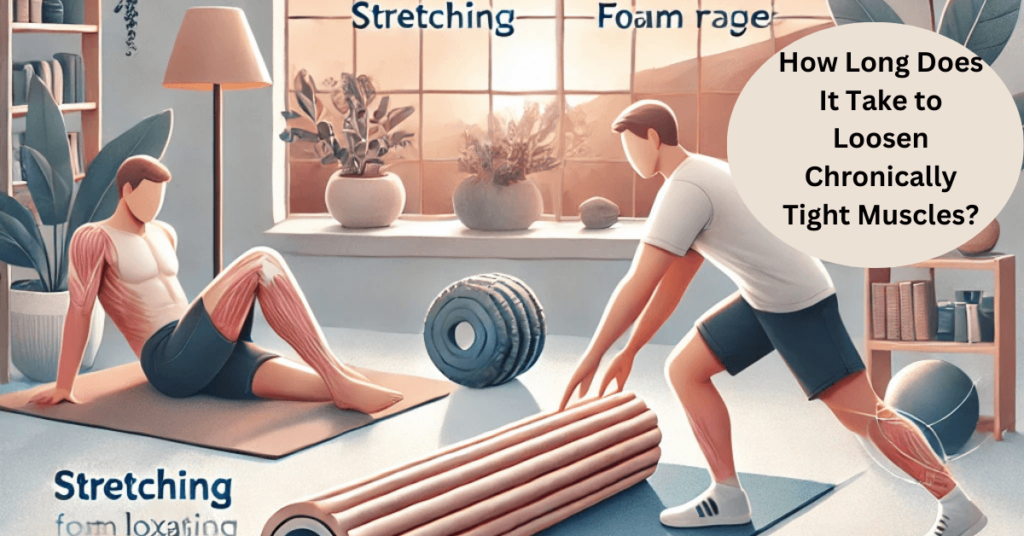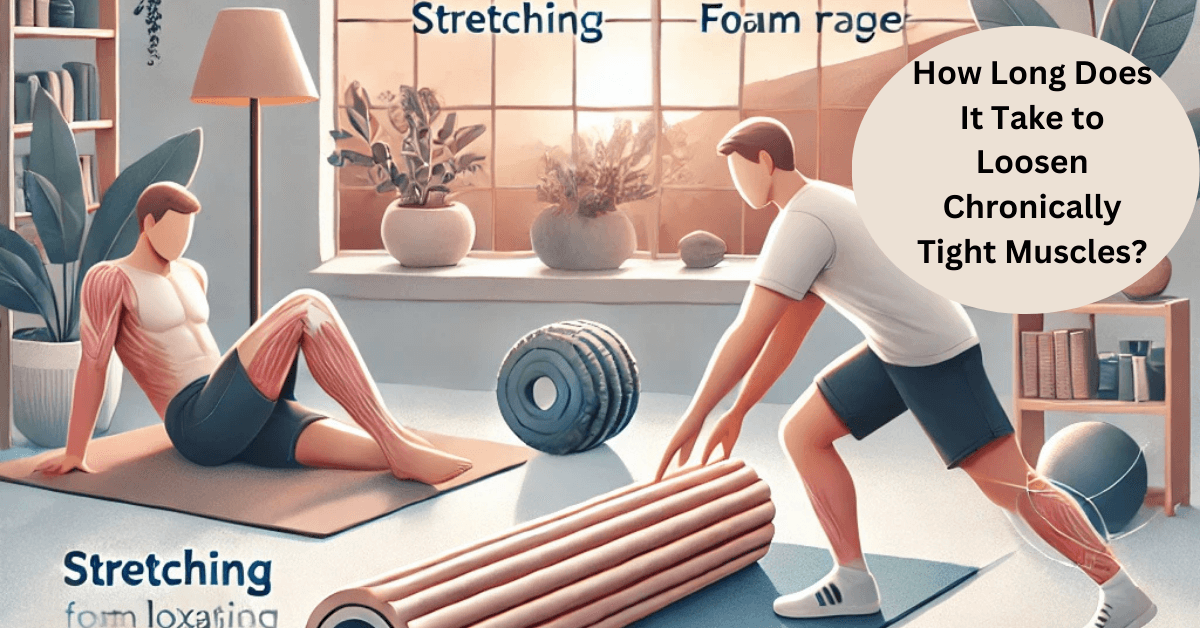How Long Does It Take to Loosen Chronically Tight Muscles? Chronically tight muscles can significantly impact your daily life, causing discomfort, limiting mobility, and even leading to more severe musculoskeletal issues over time. But how long does it take to loosen chronically tight muscles? The answer varies based on several factors, including the severity of tightness, lifestyle, and the methods used to address the issue.

Understanding Chronically Tight Muscles
Before exploring the timeline for relief, it’s essential to understand what causes chronic muscle tightness. Chronically tight muscles are often the result of prolonged stress, poor posture, repetitive strain, or lack of movement. Over time, this can lead to shortened muscle fibers, reduced flexibility, and discomfort.
Common Causes of Chronically Tight Muscles:
- Sedentary Lifestyle: Spending long hours sitting can lead to tight hip flexors, hamstrings, and back muscles.
- Overuse or Repetitive Strain: Activities that involve repetitive motions, such as typing or running, can overwork certain muscle groups.
- Stress and Tension: Emotional stress often manifests physically, leading to tightness in the neck, shoulders, and back.
- Poor Posture: Slouching or maintaining awkward positions for prolonged periods puts unnecessary strain on muscles.
- Inadequate Recovery: Lack of proper rest and recovery after physical activity can cause persistent tightness.
Factors Influencing the Time to Loosen Chronically Tight Muscles
When addressing the question of how long it takes to loosen chronically tight muscles, several factors come into play:
1. Severity of Tightness:
Mild tightness may improve in a few days with consistent effort, while severe chronic conditions could take weeks or months.
2. Age and Fitness Level:
Younger individuals and those with higher fitness levels often recover faster due to better circulation, flexibility, and muscle elasticity.
3. Lifestyle and Habits:
Consistently practicing good posture, engaging in physical activity, and avoiding prolonged immobility can speed up the recovery process.
4. Intervention Methods:
The techniques used to address tightness—such as stretching, massage, or physical therapy—play a crucial role in determining the timeline.
Effective Strategies to Loosen Chronically Tight Muscles
Loosening chronically tight muscles requires a multifaceted approach. Combining several methods often yields the best results.
1. Stretching:
Stretching is one of the most effective ways to address chronic muscle tightness. Focus on dynamic stretches before activities and static stretches afterward.
- Hamstring Stretch: Loosens tight hamstrings and improves flexibility.
- Cat-Cow Stretch: Relieves tension in the back and promotes spinal mobility.
- Chest Opener Stretch: Addresses tightness in the shoulders and chest caused by poor posture.
2. Strengthening Exercises:
Weak muscles can contribute to tightness. Strengthening opposing muscle groups helps restore balance and reduce strain.
- Core Exercises: Strengthen the abdomen and lower back to support proper posture.
- Glute Bridges: Target the glutes and reduce tightness in the lower back and hamstrings.
- Resistance Band Workouts: Promote balanced muscle development.
3. Massage Therapy:
Regular massages improve circulation, reduce muscle tension, and promote relaxation. Techniques like deep tissue massage or myofascial release are particularly effective for chronic tightness.
4. Foam Rolling:
Using a foam roller can release tension and improve muscle elasticity. Roll over tight areas slowly and focus on tender spots for relief.
5. Yoga and Pilates:
Both yoga and Pilates enhance flexibility, strengthen muscles, and reduce stress—addressing multiple causes of chronic tightness.
6. Stay Hydrated:
Dehydrated muscles are more prone to tightness. Drinking enough water throughout the day aids in muscle function and recovery.
7. Heat and Cold Therapy:
Heat therapy relaxes tight muscles and increases blood flow, while cold therapy reduces inflammation and pain. Alternate between the two for optimal results.
8. Professional Intervention:
Consulting a physical therapist or chiropractor can provide targeted treatment and personalized exercises for long-term relief.
Typical Timelines for Loosening Chronically Tight Muscles
The time it takes to loosen chronically tight muscles depends on your commitment to treatment and the severity of the issue. Here’s a general guideline:
1. Mild Tightness:
- Timeline: 1 to 2 weeks
- Approach: Regular stretching, light exercises, and hydration are usually sufficient.
2. Moderate Tightness:
- Timeline: 3 to 6 weeks
- Approach: Incorporate a combination of stretching, strengthening exercises, foam rolling, and massage therapy.
3. Severe Tightness:
- Timeline: 8 to 12 weeks or longer
- Approach: Professional intervention, physical therapy, and consistent practice of targeted exercises are necessary.
The Role of Consistency and Patience
Consistency is key when addressing chronically tight muscles. Incorporating daily routines that promote mobility and flexibility ensures steady progress. Patience is equally important, as muscle fibers take time to adapt and heal.
Tips for Staying Consistent:
- Set realistic goals and track your progress.
- Create a routine that includes stretching, strengthening, and relaxation techniques.
- Listen to your body and avoid overexertion.
Preventing Chronic Muscle Tightness
Once you’ve managed to loosen tight muscles, prevention becomes crucial to avoid recurrence. Here are some preventive measures:
- Adopt Good Posture: Maintain proper alignment while sitting, standing, and walking.
- Take Breaks: Avoid prolonged sitting by standing and stretching every 30 minutes.
- Incorporate Movement: Regular physical activity keeps muscles flexible and healthy.
- Warm-Up and Cool Down: Prepare your muscles before exercise and stretch afterward.
- Prioritize Recovery: Allow adequate time for rest and recovery after physical exertion.
Conclusion
How long does it take to loosen chronically tight muscles? The answer depends on several factors, including the severity of tightness, individual fitness level, and the methods employed for relief. While mild tightness may resolve within weeks, chronic cases require consistent effort over months.
By combining stretching, strengthening, massage, hydration, and professional guidance, you can achieve long-term relief from chronic muscle tightness. Remember, patience and consistency are your best allies in this journey. Adopting a proactive approach not only addresses current discomfort but also prevents future issues, ensuring your muscles remain healthy and flexible for years to come.

